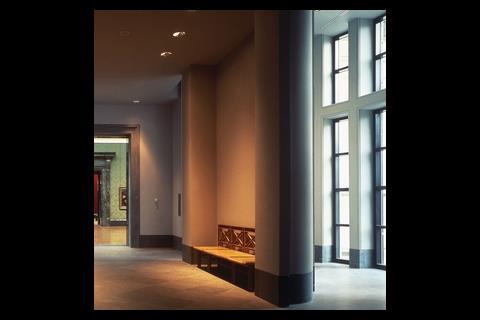Two port and three port control valve systems each have their fans, but the National Gallery found a third way, combining the advantages of both and reducing operating costs.
A building housing one of Europe’s greatest art collections might seem an unlikely place to pioneer new developments in building services technology. But last year, the National Gallery installed a high-tech control system that greatly improved the stability of plant controls in order to maintain internal environmental conditions (BSJ 06/05). Now the gallery is breaking new ground again with a hybrid chilled water system that aims to reduce operating costs.
Two ports or three?
Historically, medium temperature hot water (MTHW), low temperature hot water (LTHW) and chilled water (CHW) systems have been designed using three port control valves, where water surplus to heating or cooling requirements is diverted through the bypass instead of being sent through the coil (see Figure 1).
However, over the last twenty years or more, many systems have been designed using two port control valves which, rather than diverting excess water away from the coil, throttle back the supply. They can offer savings in capital and running costs if diversity can be applied, as pipework and pumps can be sized to match the peak load instead of the connected load. Proponents of two-port systems argue what is the point of sending water all the way around the building if it is only going to be diverted through the bypasses to no useful purpose?
But there are downsides to the two port system, including a need to install additional controls to reduce the pump speed. There may also be a need to install additional components such as pressure-reducing valves to avoid excessive pressures being developed – and to maintain valve authority and hydraulic stability – when loads decrease and control valves close.
Another downside is the limited ability to carry out flow measurement checks. For example, in a gallery or a multi-tenanted office block it can be difficult to open all of the two port control valves to 100% to ascertain if the flow to each coil is correct.
The same can be said for three port systems – however, provided the bypass valves are set correctly and the system remains in approximate balance, it’s possible to ascertain the flow with reasonable accuracy while it is operating in auto control.
The National Gallery
At the National Gallery, the LTHW and CHW systems use three port control valves. This is partly for reasons of historical precedent but also to maintain the tightly controlled space conditions. The drive to keep down running costs, however, prompted the building department at the Gallery to see if they could improve the operational efficiency of the systems without detriment to the environmental conditions.
The starting point for the project was the realisation that if the three port control valve with the highest demand is less than fully open, then there is scope for reducing the secondary pump speed via an inverter drive to reduce the flow rate to that control valve and coil.
Because, by definition, all other control valves are already open to a lesser degree, a lower flow rate would obviously suit them as well.
This is illustrated in Figure 1. Instead of continuing to run the pump at full speed with all the control valves in a mid position, the same cooling effect would be obtained if the pump were slowed down with the control valves opened further.
Determining the positions of the three port valves can be done relatively easily via the BMS, which can then adjust the pump speed accordingly so that this valve opens further under normal temperature control, saving energy.
The result is what might be termed a hybrid system that retains the benefits of a three port system (simplicity, stability and the facility to carry out flow measurements whilst the system is operating in auto control) and a two port system (reduced running costs).
The only problem was determining exactly how to configure the pump speed control strategy, based on maximum control valve demand, without sacrificing stability.
An early attempt simply tied the pump speed (expressed as a percentage between the minimum and maximum speeds) to the maximum demand of the control valve. For example, if the maximum control valve demand was 70%. the pump speed would be set to 70% of the control band between the minimum speed of 20 Hz and the maximum speed of 50 Hz, in other words 20 + 0.7 (50 - 20) = 41 Hz.
Whilst this partially met the objective, it could lead to fairly excitable pump control if there was instability in the control loop of that particular control valve as the pump would be constantly changing speed. There was also no effective integral action – in other words the system could remain in equilibrium at this valve position forever, even though there is scope for reducing the pump speed further until a control valve is 100% open.
At this point, M&E consultant Andrew Reid & Partners was brought in to develop the strategy in order to optimise performance and reduce running costs.
Improving results
It became clear that a control system that slows the pump speed when the control valve position is less than 100% open but speeds it up at 100%, is inherently unstable.
The first attempt to correct this situation incorporated a deadband of 75% to 85% open, whereby if the maximum valve position were less than 75% the pump speed would reduce and if it were greater than 85% it would increase. Within this deadband, the pump speed would remain static.
This sounded fine in theory but unfortunately in practice we found the system was unstable, with the pump speed generally oscillating either side of the deadband. It also failed to address the problem of the pump speed at times remaining static when there was scope for it to reduce further.
It was decided that a better solution might be to have a control system based on a changing pump speed as a function of the rate of change of valve position. In other words, if the maximum control valve position is increasing then the pump needs to speed up; if it is falling, it needs to slow down.
With a bit of tweaking and by incorporating a means to increase the pump speed more urgently if the maximum valve position actually reaches 100%, the results obtained were quite acceptable.
Figure 2 shows a log of maximum control valve position and CHW pump speed for the secondary circuit supplying the Sainsbury Wing of the Gallery over several days. This enabled another problem to be addressed at the same time – when the plant serving non-critical areas is switched on in the morning, this creates a sudden demand on the CHW system which causes a transient rise in CHW flow temperature and causes additional chillers to start up to meet this load. This was resolved by limiting the rate of opening of the non-essential plant CHW control valves during the first few hours of operation, which accounts for the characteristic shape of the log of maximum control valve position each morning.
The system software was developed further so that by the time the maximum control valve position reaches 100%, the pump speed is forced to maximum. This was done by creating a software point that is set when the maximum control valve position starts to rise; the minimum pump speed is subsequently increased as a linear function of control valve position. At other times, the pump speed is allowed to decay if the maximum valve position is static or falling.
The end result (see Figure 3) shows the Gallery 29 CHW pump speed changing as the maximum control valve position changes. This may not look particularly stable, but this data is taken over several days and has thus been compressed. On an hour-to-hour basis the control is quite stable and does not cause any problems in any of the controlled spaces. Bear in mind that at any time when the pump demand is less than 100%, energy and running costs are being saved.
Although it’s true these savings are not as great as could be obtained in a two port control valve system (because some water is still being bypassed through most of the control valves), they are being realised without any additional control equipment, apart from the inverter drive, and the benefits of a three port system are retained.
Applications and savings
The hybrid control system should have universal application where primary and secondary circuits are installed. It might also be applicable to two port systems to reduce the pump speed below that which would be obtained using conventional differential pressure controls (though this hasn’t been tested).
The cost savings, depending on the size of the pumps, the unit price of electricity and the particular application could be significant. In the case of the 30 kW CHW pumps used for the Sainsbury Wing East Wings at the National Gallery, the payback period is probably less than one year. If inverter drives are already installed the payback period, based on the cost of software engineering alone, might be measured in months with ongoing savings in the region of £5,000 to £10,000 per annum.
Downloads
Figure 1: Schematic of CHW system
Other, Size 0 kbFigure 2:BMS screen for Gallery 29
Other, Size 0 kbFigure3: BMS screen for secondary circuit in Sainsbury Wing
Other, Size 0 kb
Source
Building Sustainable Design
Postscript
Howard Hall CEng MCIBSE MIMechE is a mechanical engineer with Andrew Reid & Partners LLP who have worked with the National Gallery since 1990.

























No comments yet